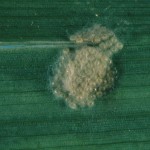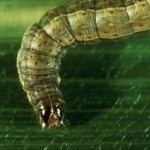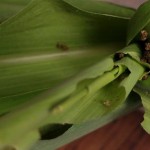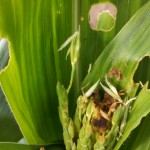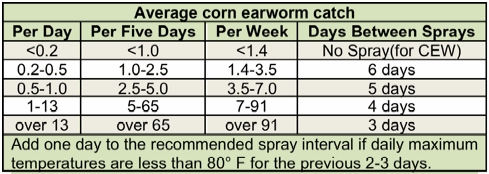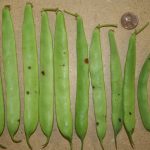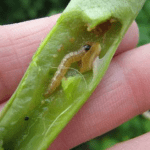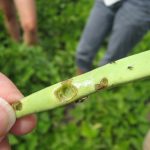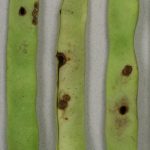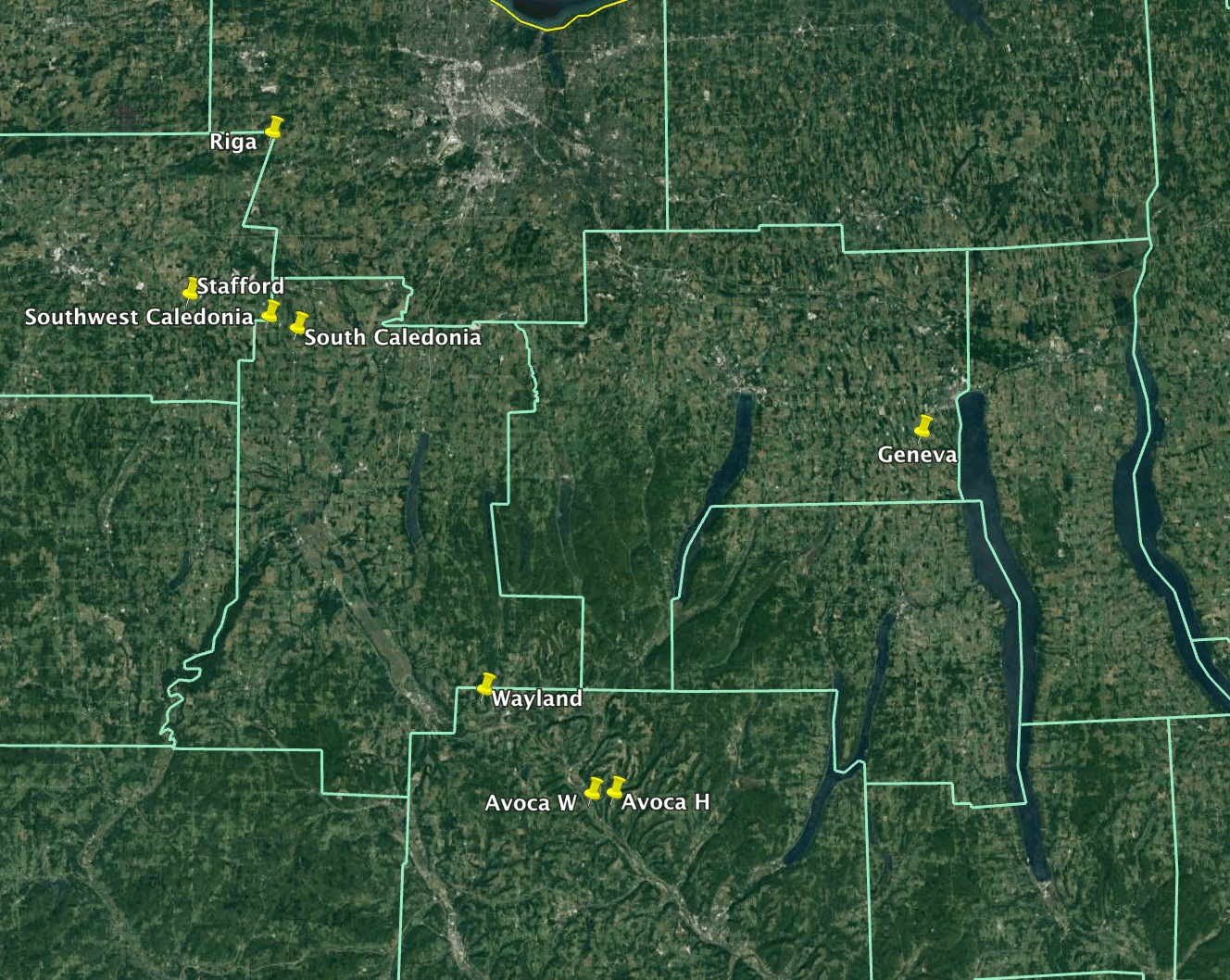Thirty sites reporting this week. European corn borer (ECB)-E was caught at six sites and ECB-Z was caught at eight sites. Sixeen sites reported corn earworm (CEW), with thirteen high enough to be on a 4, 5, or 6 day spray schedule (see table at bottom of post). Fall armyworm (FAW) was caught at eighteen sites and Western bean cutworm (WBC) was caught at twenty-three sites this week.
Where CEW are being caught in high enough numbers to drive the spray schedule, the other worm pests should also be controlled. Where FAW are being caught, a tassel emergence scout is still a good idea, as some years we see heavy FAW infestations in the emerging tassels in late plantings that may have time to get into developing ears before silk sprays for CEW. At locations where CEW numbers are still low, scout tassel emergence and silk stage fields for ECB and FAW larvae. Use a threshold of 15% infested plants in tassel emergence stage fields and 5% in silk stage fields.
- Fall armyworm egg mass.
- Fall armyworm larva, note the inverted ‘Y’ om head capsule.
- Fall armyworm feeding damage and frass.
- Feeding damage. Photo: Darcy Telenko
| Location | ECB-E | ECB-Z | CEW | FAW | WBC | DD 86/50 |
|
| Accord (Ulster Co.) | 0 | 0 | 6 | 2 | 0 | 2338 | |
| Amsterdam (Fulton Co.) | 0 | 0 | 13 | 0 | 5 | 1961 | |
| Athens (Greene Co.) | NA | NA | NA | NA | NA | 2178 | |
| Attica (Wyoming Co.) | NA | NA | NA | NA | NA | 1925 | |
| Avon (Livingston Co.) | NA | NA | NA | NA | NA | 1946 | |
| Baldwinsville (Onondaga Co.) | 0 | 0 | 6 | 16 | 3 | 1964 | |
| Basom (Genesee Co.) | NA | NA | NA | NA | NA | 2041 | |
| Batavia (Genesee Co.) | 0 | 0 | 0 | 2 | 5 | 1966 | |
| Bellona (Yates Co.) | 0 | 0 | 15 | 18 | 3 | 2012 | |
| Carlton (Orleans Co.) | 0 | 0 | 0 | 2 | 7 | 1903 | |
| Eagle Bridge (Washington Co.) | 2 | 1 | 1 | 0 | 0 | 1958 | |
| Eden (Erie Co.) | 0 | 0 | 1 | 65 | 6 | 2004 | |
| Farmington (Ontario Co) | 0 | 0 | 0 | 0 | 0 | 2045 | |
| Feura Bush (Albany Co.) | 0 | 0 | 60 | 2 | 9 | 2179 | |
| Florida (Orange Co.) | 2 | 1 | 52 | 20 | 6 | 2418 | |
| Geneva (Ontario Co.) | NA | NA | NA | NA | NA | 1991 | |
| Greenwich (Washington Co.) | 0 | 0 | 6 | 0 | 5 | 1996 | |
| LeRoy (Genesee Co.) | 1 | 1 | 41 | 36 | 5 | 1922 | |
| Hurley (Ulster Co.) | 0 | 2 | 8 | 0 | 1 | 2217 | |
| Kennedy (Chautauqua Co.) | 0 | 3 | 1 | 14 | 1 | 1924 | |
| Kinderhook (Columbia Co.) | 0 | 1 | 50 | 20 | 4 | 2190 | |
| King Ferry (Cayuga Co.) | 0 | 0 | 0 | 8 | 1 | 1904 | |
| Kirkville (Madison Co.) | NA | NA | NA | NA | NA | 1981 | |
| Lyndonville (Orleans Co.) | 0 | 0 | 0 | 21 | 74 | 1901 | |
| New Paltz (Ulster Co.) | NA | NA | NA | NA | NA | 2384 | |
| Oswego (Oswego Co.) | 0 | 0 | NA | 4 | 2 | 1701 | |
| Owego (Tioga Co.) | 0 | 0 | 0 | 0 | 0 | 1982 | |
| Penn Yan (Yates Co.) | 0 | 0 | 0 | 0 | 1 | 1951 | |
| Peru (Clinton Co.) | 0 | 0 | 0 | 0 | 22 | 1873 | |
| Plattsburgh (Clinton Co.) | 0 | 0 | 3 | 10 | 99 | 1922 | |
| Plessis (Jefferson Co.) | 0 | 2 | 0 | 0 | 7 | 1845 | |
| Portville (Cattaraugus Co.) | 1 | 0 | 0 | 3 | 0 | 1828 | |
| Preble (Cortland Co.) | 0 | 0 | 0 | 0 | 8 | 1649 | |
| Ransomville (Niagara Co.) | 1 | 0 | 2 | 19 | 5 | 2007 | |
| Schaghticoke (Rensselear Co.) | NA | NA | NA | NA | NA | 2129 | |
| Seneca Castle (Ontario Co.) | 4 | 2 | 0 | 0 | 1 | 1943 | |
| Sharon Springs (Schoharie Co.) | NA | NA | NA | NA | NA | 1906 | |
| Sherwood (Cayuga Co.) | 0 | 0 | 0 | 33 | 0 | 1916 | |
| South Colton (St. Lawrence Co.) | NA | NA | NA | NA | NA | 1621 | |
| Stone Ridge (Ulster Co.) | 0 | 0 | 3 | NA | NA | 2202 | |
| Tivoli (Dutchess Co.) | NA | NA | NA | NA | NA | 2311 | |
| Unadilla (Delaware Co.) | NA | NA | NA | NA | NA | 1711 | |
| Williamson (Wayne Co.) | NA | NA | NA | NA | NA | 1797 | |
| ECB – European Corn Borer CEW – Corn Earworm FAW – Fall Armyworm WBC – Western Bean Cutworm NA – not available DD – Degree Day (base 86/50) beginning January 1st Climate Smart Farming |
|||||||
| trap catches for the week of 8.20.19 – 8.27.19 |
|||||||
Dry Bean Western Bean Cutworm Alert
8.27.19
Marion Zuefle, NYS IPM Program
(Alert modified from Carol McNeil)
(Information and photos from T. Baute, OMAFRA)
This year we are monitoring eight WBC traps placed next to dry bean fields. The location of the traps are given in the image below. Dry bean growers should scout adjacent corn for WBC eggs and larvae when cumulative trap catch reaches 50 moths. Avoca H, Avoca W, South Caledonia, Stafford and Wayland have all reached >50 cumulative moth trap catch and nearby corn should be scouted for egg masses and damage. Peak WBC flight historically occurs the last week of July into early August but seems to be delayed by a few weeks this year. All dry bean growers should begin scouting pods for WBC feeding about 10 days after peak flight regardless of cumulative trap catch, and should continue to scout for three weeks, especially if damage has been seen in recent years.
Check 10 random spots in a field, 5 plants per spot. Inspect all the pods on the plants looking for holes. Surface feeding can be caused by other insects. WBC will mine directly into the pod and will often feed on the seed inside. European corn borer will also feed inside the pod and would most likely still be present (see image below). Slugs will also feed on the pods causing similar damage, but will often leave a slime trail (image below). If there is damage going directly into the pod and seed but no larva present, it is quite possibly WBC. During the day WBC larva are not actively feeding in the pod, instead they drop to the soil and will remain there until night. Fresh damage will be green, not brown.
- Early damage made by small WBC larvae.
- ECB in pod.
- Damage caused by slug feeding, note slime trail.
- Later feeding damage going through pod and into beans.
If you have questions contact Marion Zuefle at mez4@cornell.edu or 315-787-2379.
This project is funded by the NYS Dry Bean Industry.
| Dry Bean Location | 7.23.29 | 7.30.19 | 8.6.19 | 8.13.19 | 8.20.19 | 8.27.19 | Cumulative WBC |
| Avoca H (Steuben Co.) | 37* | 37* | 69 | 11 | 1 | 0 | 156 |
| Avoca W (Steuben Co.) | 19* | 19* | 36 | 25 | 12 | 0 | 101 |
| Caledonia South (Livingston Co.) | 0 | 44 | 20 | 14 | 14 | 12 | 104 |
| Caledonia Southwest (Livingston Co.) | 11 | 8 | 10 | 13 | 5 | 4 | 51 |
| Geneva (Ontario Co.) | 2 | 10 | 1 | 13 | 19 | 0 | 45 |
| Riga (Monroe Co.) | 17 | 61 | 80 | 83 | 62 | 14 | 317 |
| Stafford (Genesee Co.) | 5 | 28 | 23 | 23 | 15 | 9 | 103 |
| Wayland (Steuben Co.) | 40.5* | 40.5* | 73 | 108 | 31 | 21 | 319 |
| Western Bean Cutworm trap counts by date NA – not available * traps not checked on 7/23, therefore two week total divided over the two weeks |
|||||||

